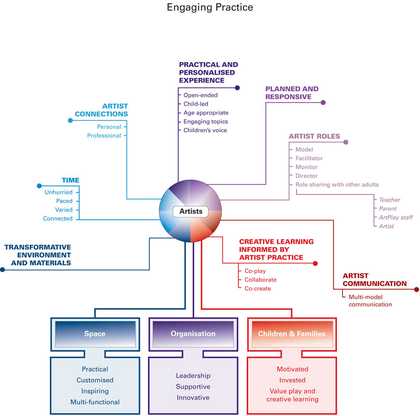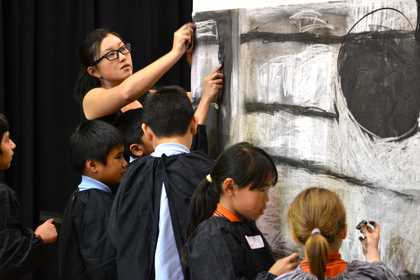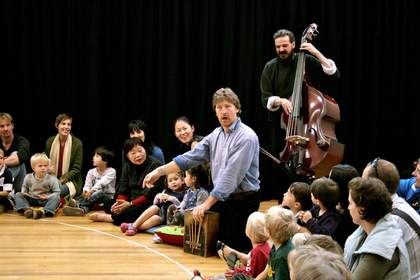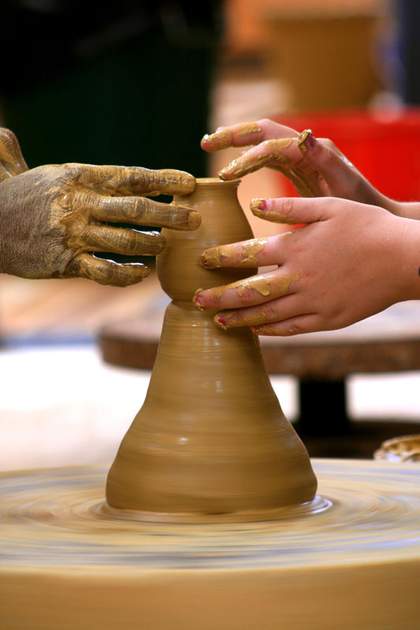What is ArtPlay?
During a period of major city development, the central train yards of Melbourne were transformed into what is now a vibrant community and cultural precinct. At this site was a dilapidated railway building awaiting demolition. Through the vision of a group of like-minded town planners, local government councilors and arts and cultural leaders, the idea evolved to develop such a site into a dedicated facility for children and families, a place to congregate and create through the arts. And so ArtPlay was born.
The opportunity arose to develop a new park in a prime river location in the centre of Melbourne, seemingly as a by-product of the nearby Federation Square, a new and significant public space at the time. The town planners were aware that life in the city was changing, and Rob Adams, an architect and urban designer and Director of City Design for the City of Melbourne, commented that ‘the city has gone from being an 8.00 to 17.00 city, to being a place where people live and spend a lot more of their time, and the residential population in the central city has grown substantially’.1 Part of the drive for this city transformation was the increasing child and family population. Morris Bellamy, Manager of the City of Melbourne’s Art and Design section, recalled that ‘the city was looking for a new strategy’, one that led planners to ‘consider seriously, for the first time, the notion of a child friendly city’. He added that the development of a park and community art space in a prime location along the river was ‘not accidental’, and that it formed part of a ‘vision for children and families to have a deeper engagement with the city … a different experience from just shopping and buying’.2
At some stage, the idea of developing a derelict building into a community arts space took root. This was partly stimulated by strong advocates Rob Adams and, later, Councillor David Wilson, who both remembered feeling restricted from undertaking arts studies in formal education when they were young, and strongly believed that children should be given more opportunities to ‘express their ideas’and to be ‘creative’.3 While the seed of an idea for what was to become ArtPlay had been planted, it was not until Rob Adams saw a unique children’s art centre in Dublin, Ireland, that the concept for ArtPlay took shape: ‘I saw in The Ark an idea that resonated with me … young kids working with professional artists in their own facility’.4 Central to the mission of The Ark is an image of the ‘citizen child’, a position developed in response to Article 31 of the United Nations Convention on the Rights of the Child, which outlines the need to ‘respect and promote the right of the child to participate fully in cultural and artistic life and encourage the provision of appropriate and equal opportunities for cultural, artistic, recreational and leisure activity’.5 This belief aligned strongly with the City of Melbourne’s aspiration to promote further social engagement with children and families. 6
Planners now had both a vision and a working model for ArtPlay. They had also identified, and were eventually to recruit, a Creative Producer for ArtPlay, Simon Spain, one of the core artists at The Ark. Rather than employ an arts administrator, key people such as Rob Adams preferred to employ an artist experienced in working with children: ‘Artists are undervalued for their creative management skills and the effort they put into their work … Just about every project (as an urban planner) involves an artist. This is threatening for some people but exciting for others who want to think outside the box’.7 This complex and timely convergence of events and developments was the catalyst for the creation of ArtPlay and a belief that it could be a ‘striking example of how Melbourne could embody the idea of a child friendly city’ and ‘offer something to children at a different level, something deep and memorable’.8
Supporters of ArtPlay had faith in its capacity to find its own form through the Creative Producer’s leadership and provide engaging arts programmes for children aged three to thirteen years. After several iterations of a business plan, the council agreed to fund ArtPlay for three years with significant support from the Myer Foundation. It was accepted that it needed to be nurtured with an arms-length approach, giving it every opportunity to succeed on its own terms. Entrusted with the license to experiment, the beginnings of programming were opportunistic, and developed, where possible, in partnership with existing festivals and established artist-in-residence initiatives. By 2012, ArtPlay had become a core business for the council.

Diagram showing the connectins between artists art and the learner
Download a larger pdf of the diagram
© Artplay
Children’s voices
Once successfully established, the council extended its commitment by funding an annual round of ArtPlay grants totalling $100,000. A grants panel was formed, one that gave children full voting rights. One such panel that we observed in 2007 included children aged seven to ten years, each partnered with a known adult (parent, guardian or family friend), artists, a representative from the Myer Foundation and the Creative Producer of ArtPlay.9 Allocated the entire day to do so, the panel’s role was systematically to work through artist submissions, discuss the merits of each, and rate these in order of preference. It was a complex process that required communication, justification, prioritisation and re-prioritisation that took into account the merits of each subsequent application. The following researcher notes, drawn from observation and interviews, highlight how children were engaged in authentic decision-making:
Seated in a board-like meeting room on level five of the City of Melbourne’s Council House 2, the atmosphere amongst panel members was relaxed, social, and also anticipatory, cognisant of the ‘serious’ task before the group – awarding one hundred thousand dollars of grants to artists wanting to work with children at ArtPlay.
When I first sat in as an observer, I was concerned that this consultation with children might be more symbolic, even tokenistic, rather than an authentic one wherein the children’s views carried equal weight to that of adults. What I noticed was a respectful and open dialogue with children, supported by guiding adults, who together considered and argued for their preferred grant recipients. The abstract nature of this task was partly alleviated by each applicant’s support materials including photographs and DVD profiles of their work.
Over the course of the day, the children became more confident to express what were astute perceptions of the elements of workshops that would not only be fun for children, but would also challenge them creatively. Speaking to these children during their lunch break, they conveyed their investment in the task and a sophisticated awareness of the responsibilities it entailed.
Researcher: How do you feel about participating in the panel?
Child 1: It’s kinda strange … you’re really affecting what’s going to happen at ArtPlay.
Researcher: What things are important when considering applications?
Child 1: It’s important how much it costs.
Child 2: And about how good it is.
Researcher: How do you know what’s good?
Child 3: It’s about what everyone wants, not just what one person wants. And you’ve got to think to yourself, do you want to recommend it?
Through the grants programme, ArtPlay was able to attract a diversity of artists, both experienced with and new to working with children. Funded initially for a small number of workshops only, such grants allowed ArtPlay to trial innovative workshops that otherwise may not have been offered because of cost or the risk of not gaining sufficient public subscription. A significant element of some grant proposals was that they targeted the participation of marginalised groups.
From the outset, ArtPlay was offering free and inexpensive, fee−based workshops but not necessarily attracting disadvantaged families, ones who were unaccustomed to coming into the city or disinclined due to travel costs. The opportunity actively to engage children from diverse backgrounds was given a boost through the support of a silent philanthropic organisation. Drawing from this funding, ArtPlay was able to support the workshop costs and travel of individuals and school groups identified as disadvantaged. In particular, this grant enabled and compelled the ArtPlay school programme to extend beyond connections made in central Melbourne to other urban and regional schools, ones who rarely come to the city. Over time, ArtPlay has continued to gain financial and other support from a range of sources and partnerships, which has extended its capacity and reach. In 2012, it presented over 450 events, programmes and workshops, including fifty days of low cost or free school workshops.

Children working with Zhen Chew in a drawing workshop
©ArtPlay
The environment
Families feel welcomed by the front of house and other ArtPlay staff who interact with them before, during and following the workshops, a service that includes making parents feel confident in their own creative abilities. Such support complements the creative role of the artist in a variety of ways. Alex Desebrock, the ArtPlay Programme Manager, observed that the staff act as ‘conduits’ who help participants to ‘interpret’ the workshop content.10 They also, according to Bobby Napier, the Front of House Facilitator, act as hosts and ‘mediate’ between the artist and the children, particularly if the artist is inexperienced in working with children:
Sometimes if they [the artists] are a bit abrupt or a bit short or don’t explain themselves well enough, or don’t show pictures or something, it’s the ArtPlay staff member’s job to sort of say ‘have you got some pictures we could maybe look at?’ So, they are really there to facilitate, to host, and make sure that it all runs smoothly. Also they need to keep an eye on any misbehaving children that are not engaged, or children with some special need and give them a bit more attention.11
The staff employed to take on these roles do not have specific training, though many have worked with children before. As Bobby says, ‘To tell you the truth, they haven’t [had training], but they all have a special quality which is patience, love for children, and love for art’.12
The space is made up of an open downstairs hall suitable for a variety of activities ranging from dance and music performances to large-scale visual arts installations. Adjacent to this space is a smaller area that can be completely enclosed and blacked out. It can transform into a seminar space, a gallery and/or a more intimate space for art-making. Located upstairs is a mezzanine area that provides a smaller workshop space suitable for more contained arts experiences. The whole building benefits from abundant natural light streaming through high, tall windows located on all four walls.
Parents are appreciative that the space has been specifically designed for children and have described the physical and psychological qualities of the environment as beautiful, relaxed, unhurried and flexible to the specific needs of children and families. As one parent said, ‘There are not too many spaces so they don’t get lost in it. They have enough space to be themselves, to feel safe in that environment, and to be creative’.13
Designed as an open modular space, the environment is continually custom-designed for the needs of each age group and art programme, helping to create an atmosphere of focused attention and home-like comfort. This capacity to transform creates a perpetual newness to how participants experience ArtPlay. As one ten-year-old boy said, ‘Oh, it just lets my imagination out. If you look around the whole place then you can see so much artwork and it’s just really, really amazing to be in here. It’s like a massive house’.14
The programmes
The workshops are generally one-off or short term and cater for different age groups. The pre –school programmes are for children aged two to five years. These are generally one - off, running for forty - five minutes to one hour and involve up to twenty children as well as parents and guardians, who are required to attend and participate. The programmes for six to thirteen year olds are generally one–off and run for two to three hours, with some continuing all day. Group numbers range widely from five to twenty – five young participants, and parent and guardians are required to attend if their child is younger than eight years old. Generally, adults are not required to participate. The school programmes involve up to twenty-five students who come with teachers to participate in a series of two or three whole – day workshops. There are also long-term programmes. These involve one group of young people (ranging from eight to thirteen years of age) who are engaged in multiple all-day workshops (four to eight sessions). To date, such programmes have only focused on music and puppetry.
The workshops are presented in an informal and relaxed manner with little sense of the pressures of time. Workshops end in different ways, sometimes culminating in a presentation/performance or final reflection, and at other times quietly finishing as individuals complete their work. What is noticeable is that the boundaries of time and place are somewhat absent at ArtPlay – once there and cocooned, the children, artists and families are focused on the task at hand. The Creative Producer, Simon Spain, uses the metaphor of the cooked and the raw when referring to the philosophy underpinning the ArtPlay studio. He notes that children are provided with raw materials by the artist and from these create their own inventions based on their interests and needs. This capacity to create is supported by the availability of engaging, artist-quality materials and an open and custom-designed studio-like environment dedicated to specific activities. As one parent noted, ‘I think it’s the simplicity of the activities. Nothing here ever really relies on lots of bells, lights and whistles. The impact the children have on the success of the programme and the participation of the parents depends very much on their imaginations’.15
The approach to the arts experiences focuses more on exploration and immersion than pre-determined, adult-directed art-making. Artists employed at ArtPlay are guided by this position, explained Alex, the Program Manager, who at times needs to advise artists to ‘limit the palette’ they are working with so more space is left for the children ‘to think about innovative ways of using things’.16

An instant orchestra workshop with families lead by Nico Brown and Martin Brunsden
© ArtPlay
The artists
In the midst of a groundswell of individual child music-making, Nico introduces more instruments, including enough angklungs for every child. At this point the atmosphere becomes even freer with children moving around to collect instruments, adults and children co-playing and Nico moving throughout, modelling one-to-one how to play various instruments. As one parent noted, the artists were ‘warm, engaging, gentle and non-confrontational. They ensured that each child had a chance to be involved’. Meanwhile a mother plays a triangle to engage her baby who sits on her lap, and all the time Martin maintains a unifying bass beat in the background.17
From the outset, the artists were conceptualised as the key figures in creating the programme. After the first year of operation, a core group of regular artists had formed. Apart from leading a number of workshops, some of these artists were eventually employed to co-develop programme strands such as the preschool, school and puppetry workshops. Balanced with this stable of continuing artists has been the periodic or one-off employment of a very diverse group of artists.
While families frequently acknowledge the benefit of the arts for their children, the opportunities, resources and skills to engage children in arts experiences can be lacking. In response to this demand, facilities such as The Ark and ArtPlay have emerged. As Bobby says:
I think for a lot of people it’s oh, let’s give this a try. But then I think what keeps bringing them back is the feeling of the place, the building itself, the staff, how friendly and welcoming we all are. How professional it is. The atmosphere that’s created by all those things, the building, the set up, but also the variety and working alongside an actual artist, not being taught a skill by a teacher or someone that talks to you like a teacher but a novice, whether they’re young, old, Australian, African you know, is an artist that is working in the field saying this is what I do, sharing it with them.18
The development of ArtPlay and the outcomes over the last eight years have shown that it is able to achieve what key advocates such as Councillor Wilson had hoped, namely to ‘help kids engage with culture, with the city, with their families and with each other’.19

Artists lead a pottery workshop with children
© ArtPlay
The research
Soon after the facility opened, communications between the City of Melbourne and the University of Melbourne were established with the goal of researching the practices and systems of ArtPlay. This partnership, with support from the Australian Research Council and the Australian Council for the Arts, led to the four-year research project, Mapping and augmenting engagement, learning and cultural citizenship for children through ArtPlay workshops with artists. The research began in July 2007 and has provided an opportunity not previously available in Australia: to conduct sustained and in-depth research within a space specifically designed for art and play experiences for children aged three to twelve.
The research has mapped the outcomes of ArtPlay primarily in relation to how children respond to workshop activities, what they gain from such activities, the role of the artists and what broader encounters with culture and community are supported through such activities. The study involved sixty-three artists, 691 children, seventy parents, twelve teachers, fifteen ArtPlay staff members, five City of Melbourne staff members, eight researchers and thirty-nine workshops, with data gathered through surveys, observations, interviews, focus groups and document analysis. It has articulated the characteristics of engaging practices and identified the conditions that support engagement, learning and cultural citizenship in this unique setting. It has also interpreted and constructed practice-based theory that will inform sustainable development and continuous improvement at ArtPlay while generating new knowledge that is accessible and transferable to other contexts involving artists working with children.
Research findings
Engagement is the foundation of learning and our analysis of observations, interview and survey data indicates that children are highly engaged by ArtPlay’s workshops. Key to this engagement are a number of factors, highlighted in Figure 1. From the beginning, the children and parents feel welcomed and comfortable at ArtPlay and the artists take on numerous roles throughout these encounters that connect with all the participants. The workshops are practical, well planned and responsive to the children’s interests and emotional needs, and involve children in playful exploration with goal-oriented and practical challenges. The workshops emphasise creative learning, co-creation, negotiation and community connectedness, and the supportive relationship between the artists and ArtPlay staff is critical to the success of the programmes. The unique physical and organisational environment of ArtPlay is another key factor for engagement, as well as the rich and quality resources provided.
This paper is part of a series that are from or in response to presentations made at the Worlds Together Conference at Tate, 2012.
